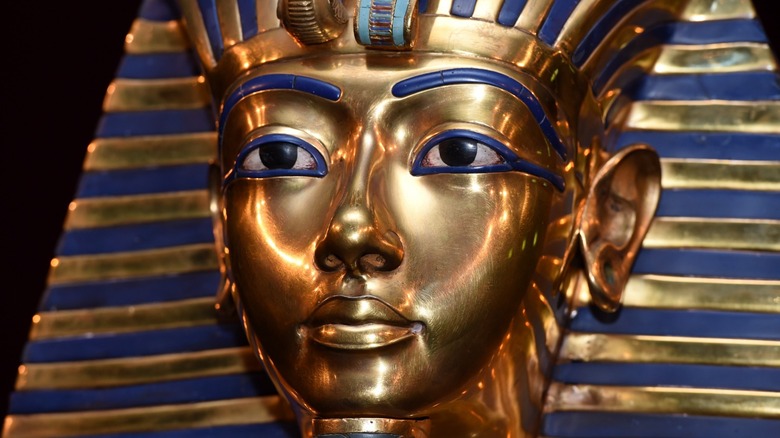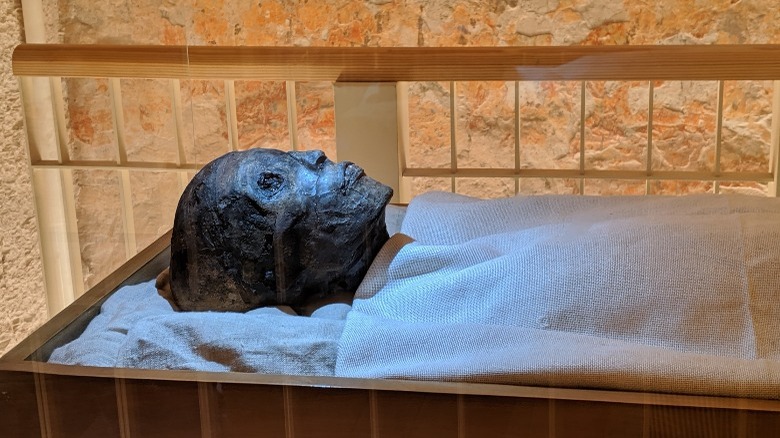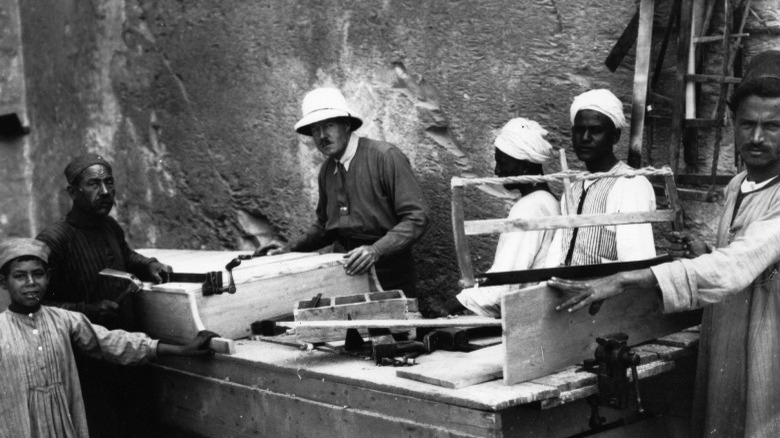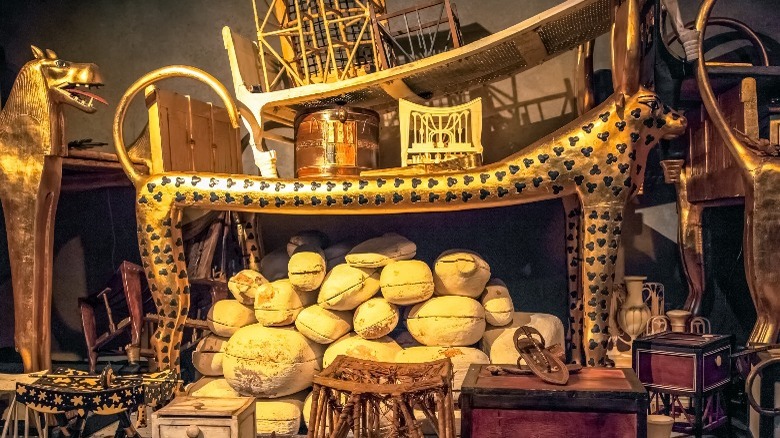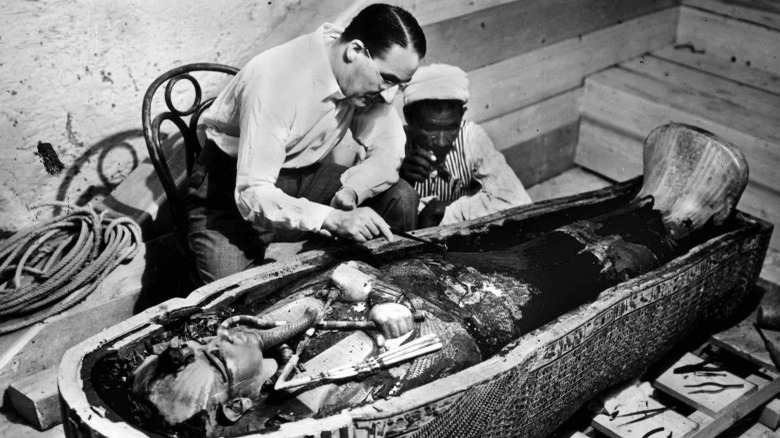The Bizarre Item In King Tut's Tomb That Baffled Scientists
The unearthing of King Tut's lost tomb is arguably one of the greatest — if not the greatest — archaeological discoveries in history. Though he was a relatively unknown historical figure until his final resting place was uncovered, today (per Biography) King Tut is probably history's most recognizable pharaoh. Unlike some of his predecessors, it was not his exceptional reign as king that made him a household name. It was the uncovering of his tomb, and the invaluable treasures that lay inside.
It was common practice that the pharaohs of ancient Egypt be laid to rest with objects representative of their wealth. According to The Guardian, elaborate sarcophagi, wall paintings, along with clothes, jewelry, and precious stones could be found in the burial chambers of the kingdom's rulers. This was also true for the tomb of King Tut. However, there was one item that was discovered that made scientists scratch their heads for decades. That object was a dagger, which it turns out may have literally been from out of this world.
Who Was King Tut?
So who exactly was the man behind history's most famous tomb? King Tut was born Tutankhaten sometime in 1341 B.C., the son of Akhenaten, aka Amenhotep IV, a powerful and revered pharaoh of ancient Egypt (per Biography). Though Amenhotep was a dominant leader, it was that authoritativeness when it came to changing the religion of his people that resulted in his downfall. After a 17-year rule, he is believed to have been deposed, and died soon after, which paved the way for his 9-year-old son to become pharaoh.
Tutankhaten changed his name to Tutankhamun when he ascended the throne. Because of his age at the beginning of his reign, it would be fair to assume that he had a lot of time ahead of him to rule his people. Unfortunately, his tenure as pharaoh was short and unremarkable. King Tut passed away at the age of 19, reportedly from a gangrene infection, and his name faded into obscurity for thousands of years.
Discovery of King Tut's tomb
According to Biography, King Tut was buried in the Valley of the Kings, like the pharaohs who came before him. However, it is believed that his burial had to be thrown together rather quickly, because the young king's death was unexpected. As a result of this, he was buried in a tomb not made specifically for him. After it was sealed, there was no documentation of him after his death, and so his tomb and its location were lost to history until the 20th century.
On November 4, 1922, King Tut's tomb was rediscovered by British archaeologist Howard Carter and his crew (per History). Over the next few weeks, they excavated the site, reaching a surprisingly intact burial chamber on November 26. The chamber itself consisted of four rooms that contained some of the objects that had been placed there to accompany the Egyptian ruler to the afterlife. Carter's perseverance following years of searching was rewarded with one of the greatest archaeological finds of all time.
Rediscovered treasures
As soon as the explorers laid eyes on Tut's tomb, it was clear they had stumbled upon a goldmine. Literally. Items of extraordinary value lined the walls and were stacked from the floor to the ceiling. When Carter wrote about the discovery later in his diary, he called it a "marvelous collection of treasures" (per Ancient Origins). After cataloging their finds for months, the total of the treasures in the tomb numbered almost 700.
There were numerous objects of all kinds unearthed in the newly discovered tomb. Some of these items included vases, elements of chariots, and even a chest containing some of the pharaoh's personal items. As impressive as these items were, the most stunning piece lay in Tut's burial chamber. King Tutankhamun had been buried in an extravagantly carved sarcophagus which itself held three more coffins that protected the ruler's remains. The final coffin that surrounded the boy king's body was also made of solid gold. Inside that coffin the expedition discovered King Tut's now-famous death mask, which was also made of pure gold and decorated with precious jewels.
An unexpected find
According to History, three years after the initial discovery of King Tut's lost tomb, Carter and his team made yet another astounding discovery. Within the folds of fabric that wrapped the pharaoh's body, there lay two different daggers. Around the king's waist was a dagger made of gold. The second was found around the king's thigh. The weapon featured an iron blade with a decorative gold handle.
While there had been enormous amounts of gold found in this tomb already, what had not been found was anything made of iron. Despite the ornate nature of the gold and jewels of the other objects there, the fact that there was anything made of iron immediately sparked interest. During this time period, iron was very rare and seen as worth more than gold. Though the ancient Egyptians had access to many different types of metals, one that they did not have ready access to was iron (per History).
Modern technology may provide more answers
There have only been a handful of iron items found from this time period. Archaeologists initially believed that the iron used to make these objects was known as meteoric metal. The ancient Egyptians even called it "iron from the sky" (per History).
During the 1970s and 1990s, the idea that the dagger was made from a meteorite (per Smithsonian) was a probability based on previous examinations. This highly controversial theory was put to the test by Italian and Egyptian researchers using new technology to test the dagger. Their findings concluded that the blade's composition of iron, nickel and cobalt really is indicative of extraterrestrial origin. Additionally, this exact composition matches a meteorite known as Kharga that was discovered in a city 150 miles west of Alexandria.
The newer methods of testing these iron objects from this time period are opening doors to learn more about ancient civilizations and their interactions with other worldly objects. Though King Tut's dagger probably wasn't given to him by aliens from another planet, it appears that it is still, in a way, from out of this world.
